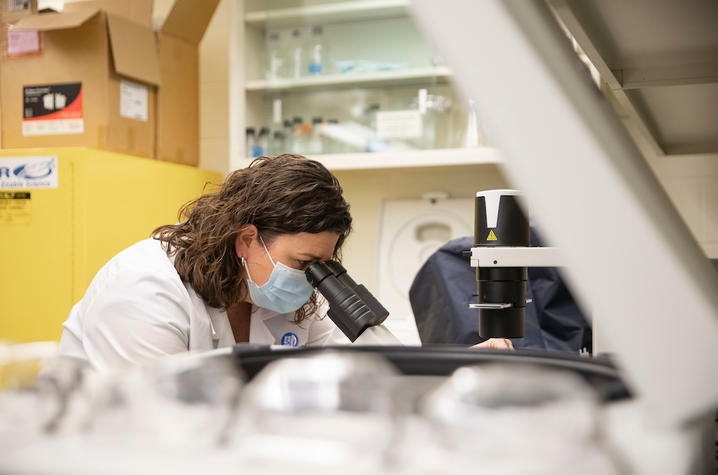Damaged Lungs Breathe Life into UK COVID Research
EXINGTON, Ky. (March 11, 2022) — A small black lump, about an inch or so in width, rests on the bottom of a sealed plastic container. It doesn’t look like much – in fact, it doesn’t look like anything. But this little black lump has untold potential, full of secrets for the researchers at Kentucky Research Alliance for Lung Disease (K-RALD) to discover about the pandemic that has ravaged the world for more than two years.
This black lump is a sample of a lung from a COVID-19 patient. Specifically, it belonged to Dave Hoover, the first Kentuckian to receive a double lung transplant after contracting COVID-19. Hoover fell ill in February 2021, and after declining rapidly, he was transplanted two months later. He donated his lungs to researchers in the University of Kentucky College of Medicine, who added it to the K-RALD biobank of lung samples.
“We’ve actually been collecting samples from transplant patients before COVID-19 hit,” said Jamie Sturgill, PhD, assistant professor for Microbiology, Immunology and Molecular Genetics in the UK College of Medicine. “We have a clinical partnership with the hospital and the transplant team, so we already had the infrastructure in place for our biobank.”
In the K-RALD lab, there is a shelf lined with plastic containers, each containing a sample of a human lung. After Hoover, five other COVID-19 patients received lung transplants at the UK HealthCare Transplant Center and many donated their damaged lungs for research. Those samples, labeled by date and identification number, are almost black in color. By comparison, a healthy lung sample is light and spongy and floats in the preservation liquid. In the COVID-19 samples, the lung’s intricate network of airways has collapsed from the fibrotic scarring, which is why it doesn’t float. The rest of the samples are from patients who had other lung diseases, such as pulmonary fibrosis.
“Other universities who don’t have pulmonary critical care biobanks like ours aren’t really able to do this type of research,” Sturgill said. “Because we already had this in place before COVID, we are actually able to compare on a molecular level what happens to a lung that is scarred from COVID to a lung that is scarred from another lung disease.”
These samples are a rare commodity – according to Sturgill, very few researchers get the opportunity to touch a human lung.
“It’s not like blood donation,” Sturgill says. “You really have to have coordination with a transplant center because that’s the only time people are going to give up their lungs. We know how precious and critical these samples are.”
When the pandemic started, scientists all over the world pooled their research and determined that the angiotensin-converting enzyme 2, or ACE2 “receptor”, is an entry point for the coronavirus to “hook” and infect a wide range of cells. K-RALD leaders Christopher Waters, PhD, and Peter Morris, MD, along with UK Vice President for Research Lisa Cassis, PhD, pivoted their research to studying the ACE2 receptor, comparing Dave’s lung to other samples in the biobank.
“I was able to match other donors in the biobank in age, sex, race, ethnicity to Mr. Hoover to other samples in the biobank that were not COVID,” said Sturgill. “We can see at the molecular level, there is a difference in the ACE2 function in the patient who had COVID versus the one who had fibrosis due to a non-infectious cause. We may be able to figure out some new pathways that would maybe prevent fibrotic changes due to the virus.”
According to Sturgill, this is one of the first studies to look at COVID lungs with a comparable fibrotic lung, owing to the availability of tissues samples from the UK Transplant Center and generous donors like Hoover. Given the collaboration with the research team and the clinician, researchers are also able to follow up with patients after their transplant to study their long-term outcomes.
Patients who receive lung transplants are more likely to experience rejection than any other organ transplant patient. Rejection is the body’s natural response to a foreign substance, such as bacteria or a virus. When fighting off pathogens, the immune system can inadvertently attack the new lung, too. Patients take medication to suppress their immune system to reduce the risk of rejection, but doing so leaves them vulnerable to infection. With the information from Hoover’s sample and others in the biobank, researchers want to stop rejection before it starts.
“Lungs are easily rejected organs,” Sturgill said. “So, we’re following up with patients post-transplant so we can understand the early markers of rejection to hopefully prevent it so that their lungs last longer.”
Researchers at K-RALD are involved in a number of clinical trials, consortiums and networks dedicated to improving the outcomes of patients with lung disease. They are looking for markers, trying new medications and developing new methods for identifying how diseases affect lung tissue on the molecular level. Their work is published and shared around the world, becoming part of a global collaboration dedicated to curing lung disease and improving not just a patient’s outcome, but their quality of life.
And it all starts with people who are willing to contribute to science, like Dave Hoover.
“We’ve really been able to make great strides in pulmonary research because of the generous donations of our patients,” said Sturgill. “I’m very thankful for that, and I tell each patient when they consent to the biobank that they’re really helping us do research and understand more about diseases.”
